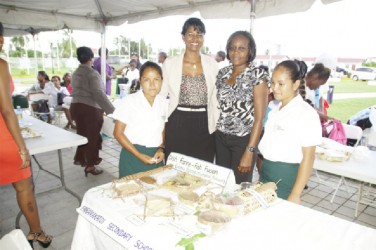Just over two weeks ago the culinary skills of the Food and Nutrition students at several of the country’s secondary schools combined to offer audiences from across the region one of the more attractive
presentations among the many unveiled in the forecourt of the National Convention Centre as part of Caribbean Week of Agriculture 2013, held from October 4-12.
The aim of Caribbean Week of Agriculture is to place farming and rural life on the ‘front burner’ of the wider Caribbean discourse on regional food security and this year’s planners, including the Food and Agriculture Organisation (FAO) planned and executed the exercise under the theme ‘Linking the Caribbean for Regional Food and Nutrition Security and Rural Development’.

Amidst the attractive but decidedly sedate food displays staged by the various Caribbean territories represented at CWA 2013 in Georgetown, the Food and Nutrition (F&N) students of secondary schools as far apart as Queen’s College and Pakamakatoi Secondary, on Thursday October 10, staged an impressive one. Employing cassava, one of the region’s most versatile root crops, they prepared a range of attractive and tasty dishes. The competition challenged the Secondary School students and their tutors to prepare and display for a panel of judges a variety of cassava-based products ranging from pizza to pastries. The dishes were judged based on criteria that included creativity and presentation. The students did not disappoint. Other pursuits being staged simultaneously as part of CWA were temporarily set aside as visitors converged on the area housing the competition to sample the various cassava delights.
Traditionally, cassava has been utilised in the making of bread, farine cassareep, pone and balls. It is also boiled and eaten as a stand-alone dish. However, the students were able to display over 50 dishes made from cassava. New Amsterdam Secondary took the top prize, while Uitvlugt Secondary and President’s College were awarded the second and third places, respectively.
The significance of the event, however, extended far beyond the competition. It was as profound a statement as Guyana made at the Caribbean Week of Agriculture 2013.
The competition was organised by FAO in collaboration with the Inter-American Institute for Cooperation in Agriculture (IICA) and the Ministry of Education.
What was most significant about the event was that it served as a reminder, first of the versatility of cassava and second of the place F&N still holds on the schools’ curriculum. It was also possibly one of the few opportunities where students from a range of secondary schools were able to pit their cooking skills against each other. The event, apart from offering a considerable measure of encouragement to local farmers, would also have encouraged local hotels and restaurants that may even be tempted to add some of the dishes turned out at the event to their regular menus.
FAO Assistant Representative Angella Alleyne told Stabroek Business that the competition sought to provide Food and Nutrition students of secondary schools in Guyana the opportunity to showcase their creativity and cooking skills as well as to highlight the use of Caribbean foods in a manner that promotes healthy living. As it turned out the event did a great deal more.
A total of 34 schools from nine of the country’s ten regions participated in the competition. Each school was presented with a trophy donated by Food and Agriculture Organisation of the United Nations (FAO). It is hoped that a cookbook of the various cassava dishes prepared by the students would be published.
The Ministry of Education must be lauded for its support in mobilising the schools. This has been an ongoing effort by the ministry over the years—mobilising and encouraged schools across Guyana to participate in various competitions organised by FAO every year as part of World Food Day which is celebrated on October 16.









